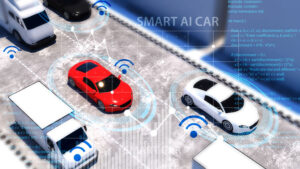Written by Scott Wilson

Self-driving cars are a poster child for the AI revolution.
Even if you don’t live in California, where San Francisco hosts the greatest concentration of self-driving cars the world has ever known, you’ve seen the amusing TikTok videos: bemused cops trying to talk to the driver of a driverless car, or a bunch of self-driving taxis creating their own traffic jam in an intersection or sideswiping a bus.
Even if you haven’t seen a full self-driving vehicle, you’ve surely encountered plenty of them that are well on their way there: Toyotas with lane departure nudges and self-braking, Hondas that park themselves in tight parallel slots, Teslas that allow owners to go entirely hands-off on certain roads in some situations.
When it comes to autonomous vehicles, the future may be now.
Featured Programs:Sponsored School(s) Campbellsville UniversityFeatured Program: MS in Data Science and Artificial Intelligence
Campbellsville UniversityFeatured Program: MS in Data Science and Artificial Intelligence George Mason UniversityFeatured Program: MSAIT - Machine Learning Engineering Concentration
George Mason UniversityFeatured Program: MSAIT - Machine Learning Engineering Concentration
All of that has emerged suddenly in the last decade or so, and it’s because of breakthroughs in a host of technologies that have one big thing in common: they live under the big tent of artificial intelligence.
Autonomous Vehicles Have a Long History That Hasn’t Lived up to the Hype
 Artificial intelligence is a must-have when you are talking about turning a machine loose on American roadways. Piloting a two-ton hunk of carbon fiber and steel around streets shared by pedestrians, motorcycles, and school buses is not a job for anything that doesn’t have intelligence—whatever that is.
Artificial intelligence is a must-have when you are talking about turning a machine loose on American roadways. Piloting a two-ton hunk of carbon fiber and steel around streets shared by pedestrians, motorcycles, and school buses is not a job for anything that doesn’t have intelligence—whatever that is.
Figuring out the whatever part has been the preoccupation of plenty of expert technologists through the history of autonomous vehicle development.
Robotics luminary Hans Moravec earned his PhD in 1980 by building a cart that would take a few snapshots of a prospective course and send them to a mainframe computer to crunch the data. Using the calculations, it would then blind drive through the first few meters, stop, and repeat the process. The average speed was about 4 meters per hour.
Advances in both the cameras and computation have improved considerably since then.
Of course, autonomous vehicles are not limited to just those with wheels. In fact, some of the biggest and earliest advances in the field have occurred overhead.
Aircraft autopilots working on a purely mechanical basis have been around since 1912. Of course, with a much more limited range of stuff that can be crashed into at altitude, the challenges were simpler. Even today, autopilots that can cruise, climb, land, and optimize flights are straightforward software programs. Tight regulations and safety requirements keep simplicity in the driver’s seat.
The introduction of drones has taken flying AI to the next level.
Without a pilot on board, computers have to do most of the flying. All a drone pilot ever does is make suggestions… the software stabilizes and moves the craft. And with AI, that software has gained the ability to navigate, perform tasks like surveillance and surveying, and to create swarms to search for missing persons or assess damage after natural disasters.
Yet despite decades of research and practical experience, truly autonomous vehicles in any realm have remained a pipe dream.
How Artificial Intelligence Is Keeping the Dream Alive for Autonomous Vehicles
 Better AI has changed the equation entirely. And as even more breakthroughs follow in the various areas of robotics and smart pilots, it’s going to keep changing until more robots are driving cars than people are.
Better AI has changed the equation entirely. And as even more breakthroughs follow in the various areas of robotics and smart pilots, it’s going to keep changing until more robots are driving cars than people are.
The Society of Automotive Engineers specifies five different levels of self-driving autonomy in cars, from zero, where only warnings are issued to human drivers, to five, where a human will do nothing more than set the destination.
To get to full-on level 5 autonomous vehicles, several areas of critical AI research and development must be conquered:
- Sensor systems such as cameras, sonar, LIDAR, GPS, and radar
- Mechanical control system to operate steering, acceleration, and braking
- Navigation and pathing, both on the micro (within the roadway, around other vehicles and pedestrians) and macro (around the city and country to a final destination) levels
And finally, a total systems integration has to happen to get all of those features talking to one another and working in harmony.
It’s a big job… or rather, a lot of different jobs.
Jobs in Autonomous Vehicle Development Are Already Booming
 There’s room for a lot of different sub-specializations in autonomous vehicles. Since they bring together many different elements of AI technology, everything from specialists to big-picture design and integration experts will play a part.
There’s room for a lot of different sub-specializations in autonomous vehicles. Since they bring together many different elements of AI technology, everything from specialists to big-picture design and integration experts will play a part.
One position that has already hit the big-time in autonomous vehicle design is that of computer vision engineers. Image processing is such a huge piece of the puzzle that these roles need to be filled early in development.
Other positions will include specialists like:
- Sensor system engineers
- Systems engineers
- Automation programmers and autopilot software engineers
- Electrical engineers
- Autonomous vehicle simulation engineer
- AI Navigation systems engineer
Some of these positions are open to individuals with a bachelor’s degree, and more are likely to become available as self-driving vehicles become more widespread and enter routine production. You don’t need an advanced education to build or maintain the systems once they are designed.
While the field is still in that design phase, though, most of the jobs will require a graduate level of education.
Many Options Are Available for Studying AI for Autonomous Vehicles
 At the intersection of AI and industrial robotics, autonomous vehicles have been a dream for many for a long time. So there are a wide range of AI degrees available that are aimed directly at preparing people for careers in this field.
At the intersection of AI and industrial robotics, autonomous vehicles have been a dream for many for a long time. So there are a wide range of AI degrees available that are aimed directly at preparing people for careers in this field.
Of course, you can easily lay the groundwork with a Bachelor of Applied Science in Robotics and Autonomous Systems. But more general programs, like a Bachelor of Computer Science specialization in Artificial Intelligence and Robotics will also open the door.
There are even two-year degrees available in this area, like the Associate in Robotics and Automation Technology.
Many positions in this field today still require a master’s degree in AI or even a doctorate. At that level, many universities offer degrees such as:
- Master of Science in Engineering (MSE) in Robotics with AI and Machine Learning specialization
- Master of Engineering for Computer Vision and Control
- Master of Science in Engineering Robotics with Specialization in Computer Vision
- Master of Science in Artificial Intelligence Autonomous Systems Concentration
- Master of Science in Artificial Intelligence specializing in Robotics and Agent-based Systems
At the heart of these degrees are studies in field like:
- Automotive sensor and actuators
- Safety control systems
- Embedded systems programming
- Virtual world engineering principles
- Mobile robotics
Educational AI certificate programs are another option for building skills in those areas. Designed to build on the education from degree programs in related fields, like a Bachelor of Science in Artificial Intelligence or a Bachelor of Science in Computer Science, these consist of only a few classes. That makes them both fast and relatively inexpensive to complete. For anyone with the core abilities in math, coding, and statistics, they are a fast path to build up specialist skills in a hot field.
Because they are so compressed, they are also very focused. Options like a Robotics and Autonomous Systems Graduate Certificate or a Smart and Autonomous Vehicles Certificate layer on the specialist knowledge required in this field.
Certifications in Certain Areas of AI May Become Important for Autonomous Vehicle Engineers
 Professional certification sounds like an educational certificate, but there are important differences in how they are earned and what they mean.
Professional certification sounds like an educational certificate, but there are important differences in how they are earned and what they mean.
An educational certificate is just that: an education. It takes the same grade of college studies as are found in a full degree and offers them in a specialized area with specific learning objectives in mind.
A certification, on the other hand, validates knowledge and skills. They are typically offered by professional organizations or vendors, and assess the background, understanding, and abilities of people who earn them.
Only a handful of AI and ML certifications are available today, although those numbers will grow. Some will be valuable in various types of autonomous vehicle engineering jobs as validation of underlying skills with the toolsets being used. Others have a more direction application in the field, like the Certified Computer Vision Expert Certification from IABAC (International Association of Business Analytics Certification).
Since autonomous vehicles are also essentially robots, some professional certifications in robotics could also be worthwhile. The Robotics Education & Competition Foundation (REC) offers a Robotics Industry Certification as one example. Requiring 150 hours in robotics training and passage of a 90-minute test, it covers drives systems, controls, and related engineering fundamentals.
More generally, the International Society of Automation offers the Certified Automation Professional (CAP). It has more stringent experience and education requirements but comes at automation from a broader perspective than just robotics.
In all its various specialties, artificial intelligence will be crucial to getting autonomous vehicles on the right road. Handling the many challenges of navigation, safe operation, and integration with the existing traffic system is the ultimate test of robotics capability. It will take elite AI engineers to make it all happen.







